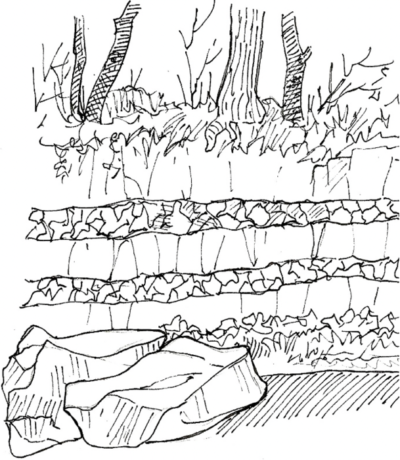As an outdoor enthusiast relocated to northwest Arkansas more than a decade ago, the observation of abundant chert was one of my very first Ozark impressions. And it was not necessarily pleasant. The chert attracted my attention in the form of baseball-sized angular rocks hidden in the deep leaf litter of Ozark National Forest hiking trails. These potentially ankle-twisting nuisances came as a real surprise and forced me to pay far too much attention to my footing when I would rather have been enjoying pleasant fall scenery. Almost at the same time I began to notice sections of trail constructed into the sides of hills that seemed to have been deliberately paved with gray gravel composed of similar angular rock fragments. By now all of this is a familiar part of my local hiking experiences. But what exactly is chert, and where did all the chert in the Ozarks come from?
Chert is a glass-like form of rock composed of tiny quartz (silicon oxide) crystals verging on a true glass where molten rock cooled so quickly as to be left with no crystal structure at all. Trace minerals mixed in with the silica give the various forms of chert their color. Common forms of chert include flint, jasper, agate, chalcedony, and onyx. Chert deposits in the nearby Ouachita Mountains were subjected to the heat and pressure of mountain building and have become the rock known as novaculite. Some novaculite deposits contained such useful materials for stone implements that they were visited by prehistoric hunters from hundreds of miles away.

Typical angular chert fragments superimposed on road cut with massive gray layers of limestone and thinner beds of fragmented chert. The sharp-edged fragments are produced when the brittle chert beds shatter during uplift.
Chert is mostly derived from oceanic sediments known as marine ooze composed of the silica skeletons of radiolarians, diatoms and other tiny marine animals. The microscopic skeletons are sometimes preserved intact in a rock called radiolarite. More often, the silica re-mobilizes and collects in layers and pods within the surrounding layers of sediment. If you look at fresh roadcuts in the Ozarks you can see thick layers of gray limestone interbedded with tan or white layers of angular rock fragments that are composed of chert. The chert layers have a kind of mottled look because of their network of brittle fractures and various degrees of mineral staining. The small springs you see in intermittent sinking streams represent places where impermeable chert beds deflect infiltrating water descending down through solution openings in the overlying limestone karst. The upland Ozark soil is a reddish clay (geoscientists call it terra rossa) composed of clay minerals left behind when limestone in the bedrock dissolved over eons. The iron-stained chert fragments left behind form a sort of gravel-like residue. This explains why there is often a knee-high carpet of low-bush blueberry on Ozark ridges – a plant known to require acidic soil not usually associated with calcareous limestone.
Chert is especially abundant in our area due to an accident of geologic history. As a rule, ocean waters are starved of certain nutrients, one of which is silica. Any silica deposited onto the ocean surface by winds from the land is quickly taken up by diatoms and radiolarians. The ancient Ozark landscape was a shallow ocean shelf just north of the active mountain building from continental collision forming the Ouachita Range about 300 million years ago. Volcanic activity in that mountain building process produced a steady rain of silica-rich volcanic ash that supported a flourishing diatom community.
Millions of years later, the presence of chert fragments embedded in Ozark rock layers provided the abrasive needed to create the deep canyons like that of the Buffalo that we enjoy today. More recently, chert impacted my professional life during my first geological investigation in the Ozarks. This was a project to lower sophisticated geophysical probes into boreholes drilled as part of a mineral assessment program in southwestern Missouri. On one of these projects a small chunk of chert dislodged from the borehole wall and became wedged against the side of my probe. That was the only time in a long career when I had to leave a piece of valuable equipment permanently embedded in the ground I was sent to study. In the Ozarks, chert happens.
